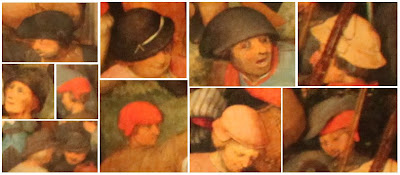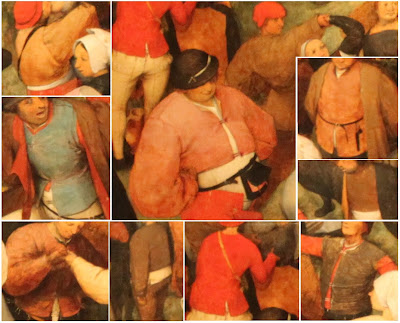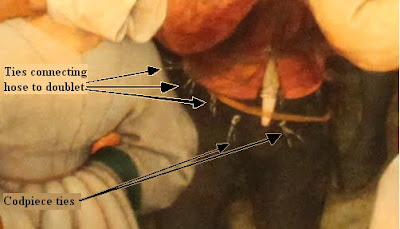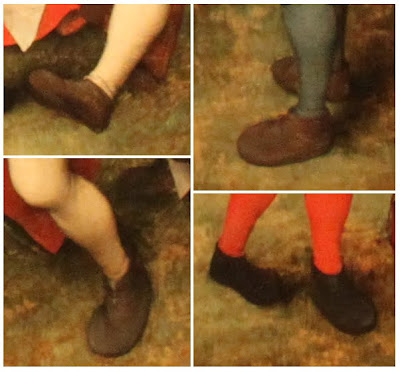In general, key components of peasant costumes for men during this time in Flanders are:
- Clean shaven, bowl hair-cut
- Shirt – long, white undershirt, worn next to skin
- Doublet – worn over shirt, tight across upper body from neck to waist, sleeves are wrist-length and loose with a closer-fitting cuff around the wrist
- Jerkin – optional wear, over the doublet, pleated at waist, knee-length, mutton-sleeves
- Hose – snug, two legs sewn together, covering the feet, held up by tying to the bottom of the doublet, front opening covered by codpiece
- Codpiece – tied across front opening in the hose
- Shoes – loose cloth coverings, tied on top, worn over hose
Colors of Peasant Clothing
The peasants in Bruegel’s painting are wearing brightly colored, festive clothing. Generally, brightly colored clothing is associated only with wealthy persons during the Renaissance period. However, Amy Greenfield, in her book A Perfect Red, notes that “More prosperous peasants, craftsmen, and other middling folk dressed in muted clothing colored with cheap, domestic dyes. Although such dyes could sometimes yield strong blues, yellows, oranges, and greens, the fabrics tended to fade quickly, especially if the wearer worked outdoors.”(1)
Also, some artistic license may be at work here. Greenfield continues, “Peasants sometimes appear brightly dressed in medieval and Renaissance works of art . . . This is less a reflection of peasant wardrobes than of the fact that wealthy patrons could afford precious pigments and expected their artists to use them. Although some people in the lower ranks may have worn colorful clothes from time to time, particularly for special occasions, most of the vivid hues commonly worn by the wealthy were beyond their reach.”(1) Since this is a wedding dance, the clothing worn may be more colorful than normal, everyday wear.
Hats for Peasants
The above peasant is wearing a brown hat with a brim. The crown of the hat is shaped like an upside-down bowl. It appears to be made with cloth, like linen or wool. Possibly it is felted wool.(2) It does not appear to be straw. The hatband consists of a simple, white cord or string tied around the base of the crown. All of the men in the picture are wearing hats; if not this style then another.

Various Renaissance hats for peasants, from The Wedding Dance, 1566 by Pieter Bruegel the Elder.(3) The two men on the right are musicians.
Hair and Beard Styles for Peasants
None of the men in the painting have mustaches or beards. Clean shaven is clearly in style. Hair is worn short, in a bowl-cut. It reaches to the nape of the neck, covers the top half of the ears and is short in front with bangs coming half-way down the forehead at most.
Shirts for Peasants
Next to the skin is a long, linen undershirt. It is white in color and has a high neckline that is just barely visible above the top of the doublet. The shirt is also visible between the doublet ties across the chest, and around the waist between the doublet and hose. It is at least mid-thigh length; long enough to go past the groin.
Doublets for Peasants
Over the shirt is worn a doublet. It is form-fitting across the upper body and goes from the neck to the waist. The sleeves of the doublet are likely wrist-length and of medium tightness. The doublet is secured across the front of the chest with ties. It consists of two or more layers of material, wool or linen. Possibly made with sheepskin.(4) Colors are red, pinkish-red, blue and brown. Not all peasants are wearing the same style. Some of the doublets are seamless across the front.
Jerkins for Peasants
The jerkin is worn over the doublet. It is pleated at the waist, roughly knee-length, sometimes with a red inner lining. Jerkins are not worn by all the men in the painting. Perhaps this was a matter of choice, with those people who were hot taking off their jerkins. Possibly wool, the waist is set at belly button and small of back level. Probably, since these are peasants, the inner lining is dyed with madder plant dye, rather than the more expensive cochineal insect dye. Though “Deep, rich reds were also popular among peasants and small farmers . . . both legal strictures and the prohibitive cost ensured that they rarely had a chance to wear them. At best, peasants could afford only the cheaper orange-red and russet dyes.”(1) Outer layer of the jerkin is brown, black, pinkish-red and grey. On some jerkins it looks like the inner layer is separate from the outer layer. The ‘mutton-sleeves’ are wide around the upper arm and tighter around the lower arm.
Hose for Peasants
Snug hose cover both legs from toe to hip or waist.. Made with wool or linen.(5) Colors of hose included tan, brown, white, red, blue and dark brown. The hose legs are sewn together over the buttocks with a gap left along front. The gap in front allowed the hose to be pulled on over hips. Hose was tied to bottom of doublet through eyelets in order to keep it from falling down. In fact, one of the purposes of doublets was to keep up the hose.(6) A back view of one peasant shows a seam going up the back of each leg.
Codpiece
The codpiece was a pouch of fabric used to cover the genitals and was tied over the gap in the front of the hose. It was made with the same material as the hose. Its primary purpose was for modesty. However, padded and stylized, codpieces “. . . became a way to advertise one’s masculinity. . . Some [fashionable men] even used them as a sort of pocket, hiding small weapons or valuables there.”(7)
Shoes for Peasants
The shoes appear to be made with cloth. Probably linen and wool. They are tied across the top and gather loosely around the lower ankle. Nothing too complex. No arch support in these!
Pieter Bruegel the Elder was a talented painter of the Northern Renaissance. His paintings feature peasants and middle-class people during the late 1500s in Flanders. Flanders was a region in Northern Europe that included parts of what is today north France and Belgium and south Netherlands.(8)
Sources
1. Amy Butler Greenfield, A Perfect Red: Empire, Espionage, and the Quest for the Color of Desire (New York: HarperCollins Publishers, 2005), 27.
2. Joan Nunn, Fashion in Costume 1200 – 1980 (Lanham, MD: New Amsterdam Books, 1998), 50.
3. http://en.wikipedia.org/wiki/Pieter_Bruegel_the_Elder
4. Francois Boucher, 20,000 Years of Fashion: The History of Costume and Personal Adornment (New York: Harry N. Abrams, Inc., Publishers, 1966), 246.
5. Sara Pendergast and Tom Pendergast, Fashion, Costume, and Culture, vol. 2 Early Cultures Across the Globe ed. Sarah Hermsen (New York: The Gale Group, 2004), 304.
6. Valerie Steele, Ed.-in-chief Encyclopedia of Clothing and Fashion vol. 1 (Detroit: Thomson Gale, 2005), 374.
7. Sara Pendergast and Tom Pendergast, Fashion, Costume, and Culture, vol. 3 European Culture from the Renaissance to the Modern Era ed. Sarah Hermsen (New York: The Gale Group, 2004), 474.
8. Wikimedia Foundation, Inc., “Flanders,” 31 December 2010 [on-line article]; available from http://en.wikipedia.org/wiki/Flanders; internet; accessed 18 January 2011.
9. Adapted from map of Europe by Google, 2011 [on-line map]; available from google.com; internet; accessed 12 February 2011.
Thank you for reading my blog about Renaissance peasant clothing for men!










